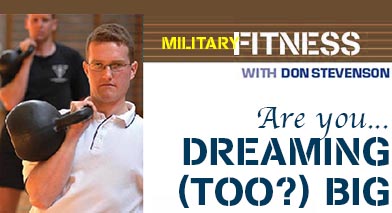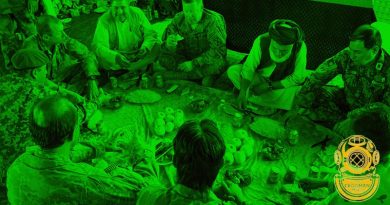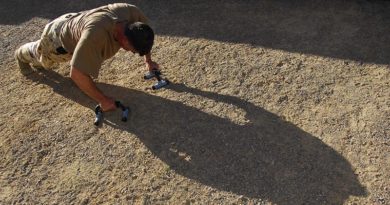Military Fitness – Part 32


I answer a lot of questions about military fitness and write a lot of programs to help people achieve their military-fitness goals. Mostly when people come to me for advice they have a fairly realistic view of their current fitness level and what is required to reach their desired goals.
However, on a fairly regular basis, I get requests that go something along the lines, “I’d really like to reach a Special Forces level of fitness this year” – which is fine except that some further questioning reveals that the person asking hasn’t done anything more vigorous than walk to the fridge in between sessions of playing Tom Clancy’s Ghost Recon and has now suddenly decided that they want to achieve a level of fitness that takes most active, serving infantry soldiers six months to a year to achieve, even when coming off a high base!
The problem here is one of levels. It’s fine to have big goals – in fact big goals are critically important for staying focused when little stuff (like life) gets in the way of training – BUT, if you embark on a journey to become SAS or Delta Force fit without acknowledging and going through the preceding levels of fitness, I am willing to bet you a slab of beer and 12-dozen donuts that you will end up hurt and despondent within a couple of months.
To avoid these pitfalls, I have recently developed a simple system of fitness assessment that allows an individual to get a clear picture of their current medical, motivational and fitness status and covert that into an assessment of the level of training at which they should commence their military-fitness journey.
 The testing, levels and subsequent programs alluded to in this article form the foundation for Couch to Commando by Don Stevenson – a 165-page e-book with programs in 6 different levels to progress anyone from couch potato to commando candidate.
The testing, levels and subsequent programs alluded to in this article form the foundation for Couch to Commando by Don Stevenson – a 165-page e-book with programs in 6 different levels to progress anyone from couch potato to commando candidate.
20% of proceeds from the sale of this e-book will be donated to Soldier On
.
The first thing most people are probably asking at this stage is, “how is this different from just running a standard fitness test and seeing where I’m at?”
Good question. The answer is that this assessment is far more detailed than any standard fitness test. It includes several stages, which are completed sequentially only after the preceding stages have been completed to a satisfactory standard. Can’t complete 20 proper pushups? Then you have no business testing your performance on bench press and pull-ups.
The assessment also includes a detailed question designed to take stock of an individual’s readiness to undertake a military-fitness program. Often when someone decides to pursue a fitness goal, they may have lifestyle factors that have the potential to interfere with their ability to complete a training program. Factors such as long work hours, lack of access to equipment, old injuries or family issues can all impact on success, and none of these are tested in a simple fitness test.
Once completed, this comprehensive fitness test and inventory can be used to prescribe training that is matched both to the goal and to the start point.
So let’s talk levels
In the military-fitness spectrum, I believe that the following levels of fitness exist.
Level 1 – Couch Warrior. Pretty simple this one. If you haven’t done any exercise for years and struggle to walk up a set of stairs or complete a handful of pushups then this is where you are.
Level 2 – Pre-Recruit. Someone who is active but who may not have any specific experience in the relevant exercises and who has not yet achieved the minimum entry requirements of their chosen service.
Level 3 – General service. This covers the level of fitness required for passing basic training and ongoing fitness requirements for any roles in the services that do not regularly require strenuous exercise in the performance of duties. An individual at this level should be able to complete the minimum requirements of their basic fitness assessment without any more than a couple of weeks of tune-up training (preferably on a no-notice basis).
Level 4 – Infantry. The level of fitness required to be a member of an infantry section involved in regular bush time or operations. This level also covers any role that requires repetitive heavy lifting, digging and so on. It is not limited to members of infantry units.
Level 5 – Special Forces Candidate. This level covers the period leading up to special-forces screening and selection courses.
Level 6 – Special Forces Member. The fitness level of an active member of a unit such as the SAS, commandos or clearance divers.
So, what’s the take-home message from all of this? Basically it is this – before you begin a process of trying to improve your fitness, you need to understand where you are starting from and where you need to go.
.
.
.
.
.
.
.
.
.

.
.

.






